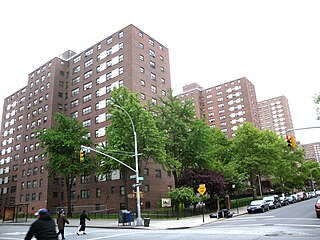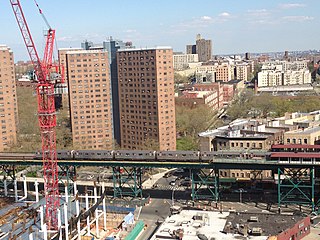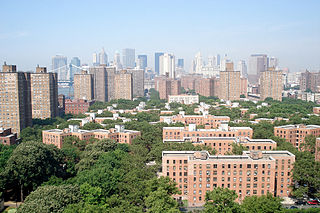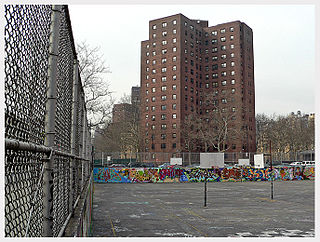
The New York City Housing Authority (NYCHA) is a public development corporation which provides public housing in New York City, and is the largest public housing authority in North America. Created in 1934 as the first agency of its kind in the United States, it aims to provide decent, affordable housing for low- and moderate-income New Yorkers throughout the five boroughs of New York City. NYCHA also administers a citywide Section 8 Leased Housing Program in rental apartments. NYCHA developments include single and double family houses, apartment units, singular floors, and shared small building units, and commonly have large income disparities with their respective surrounding neighborhood or community. These developments, particularly those including large-scale apartment buildings, are often referred to in popular culture as "projects."

Senator Robert F. Wagner Houses, also known as Triborough Houses, is a public housing development in the East Harlem neighborhood of Manhattan, in New York City and is administered by the New York City Housing Authority. It is located east of Second Avenue in the northeast corner of Manhattan, consists of fourteen 16-story buildings and eight 7-story buildings, a total of 22 buildings. It has 5,290 residents who live in 2,162 apartments. The complex occupies 26.91 acres (10.89 ha). It cost $30,926,000 to construct.

The Robert Fulton Houses is a housing project located in the Chelsea neighborhood in the New York City Borough of Manhattan and is owned and operated by the New York City Housing Authority (NYCHA). The 6.27-acre (2.54 ha) site is located between West 16th and 19th Streets and bounded by Ninth and Tenth Avenues. The project consists of 945 apartments in eleven buildings; three of the developments are 25 stories, while the others are 6 stories high.

The Frederick Douglass Houses are a public housing project located in the New York City borough of Manhattan, in the Manhattan Valley neighborhood of Upper West Side, named for civil rights pioneer Frederick Douglass. The actual buildings are located between 100th Street and 104th Street, to the east of Amsterdam Avenue and the west of Manhattan Avenue. The complex is owned and operated by the New York City Housing Authority.

Breukelen Houses, also known as Breukelen or Brookline Projects, is a large housing complex maintained in Canarsie, Brooklyn, by the New York City Housing Authority (NYCHA). Its main office is located at 618 East 108th Street, Brooklyn, NY 11236. It is bounded by Flatlands Avenue, East 103rd Street, Williams Avenue and Stanley Avenue. The community sits on 64.98 acres (26.30 ha) and consists of 1,595 apartment units inside 30 structures, all of which are either three or seven stories high. As of March 2008 the population was estimated to be 4,038.

St. Nicholas Houses or "Saint Nick," is a public housing project in Central Harlem, in the borough of Manhattan, New York City and are managed by the New York City Housing Authority (NYCHA). The project is located between Adam Clayton Powell Jr. Boulevard and Frederick Douglass Boulevard, spanning a superblock from 127th Street to 131st Street. The project consists of thirteen 14-story buildings containing 1,523 apartment units.

Manhattanville Houses is a public housing project in the Manhattanville section of West Harlem, in the borough of Manhattan, New York City. The project is located between Broadway and Amsterdam Avenue, spanning a superblock from 129th Street to 133rd Street and is managed by the New York City Housing Authority. The project consists of six 20-story buildings containing 1,272 apartment units.

The Jacob Riis Houses are a public housing project managed by the New York City Housing Authority (NYCHA) in the East Village in New York City. The project is located between Avenue D and the Franklin D. Roosevelt Drive, spanning two superblocks from 6th Street to 13th Street. The project consists of thirteen buildings, between six and 14 stories each, containing 1,191 apartment units.

The John Haynes Holmes Towers is a public housing project for low income residents of the Yorkville section of the Upper East Side located just south of the neighborhood's northern limit at 96th Street, in New York City, New York, United States. The neighboring Isaacs Houses and the Holmes Towers border East Harlem, which has the second highest concentration of public housing in the United States. The two public housing buildings, designed by Architects Eggers and Higgins, were completed in 1969, are 25 stories tall and contain 537 apartments. The project is located between 92nd and 93rd Streets from 1st Avenue to York Avenue and the FDR Drive.

Governor Alfred E. Smith Houses, or the Alfred E. Smith Houses. is a public housing development built by the New York City Housing Authority in the Two Bridges neighborhood of the Lower East Side of Manhattan. There are 12 buildings in the complex; all are 17 stories tall. It covers 21.75 acres (8.80 ha), has 1,931 apartments, and houses an estimated 5,739 people. The grounds are bordered by St. James Place to the west, Madison Street to the north, Catherine Street to the east, and South Street to the south.
Bracetti Plaza, or Mariana Bracetti Plaza, is a public housing development built and maintained by the New York City Housing Authority in Alphabet City, a section of the East Village neighborhood of Manhattan. The development is named after Mariana Bracetti (1825-1903), a legendary Puerto Rican woman who was known as the "Arms of Gold", and who was the first to craft the Boriquas Latin Cross, Puerto Rico's first flag. The flag was designed by Dr. Ramon Emeterio Betances, and is still a symbol of the Puerto Rican independence movement.
Samuel Gompers Houses, also known as Gompers Houses, is a public housing development built and maintained by the New York City Housing Authority (NYCHA) on the Lower East Side of Manhattan on Pitt Street between Delancey and Stanton Streets. Gompers Houses is composed of two 20-story buildings with 474 apartments that house approximately 1,116 people. It is built on a 3.7 acres (15,000 m2) site bordered by Stanton Street to the north, Columbia Street to the east, Delancey Street to the south, and Pitt Street to the west.

Rafael Hernandez Houses, also known as Hernandez Houses, is a public housing development built and maintained by the New York City Housing Authority (NYCHA) on the Lower East Side of Manhattan.

Mayor Fiorello H. LaGuardia Houses, also known as LaGuardia Houses, is a public housing development built and maintained by the New York City Housing Authority (NYCHA) on the Lower East Side of Manhattan. Mayor Fiorello H. LaGuardia Houses is composed of thirteen buildings, all of which are sixteen stories tall. The buildings have 1,093 apartments and house approximately 2,596 people. The complex occupies 10.96 acres (4.44 ha), and is bordered by Madison Street to the north, Montgomery Street to the east, Cherry Street to the south, and Rutgers Street to the west. LaGuardia Houses Addition is a sixteen-story tower for elderly people at the corner of Jefferson Street and Cherry Street.
Lower East Side I Infill, or Lower East Side Infill #1, is a public housing development built and maintained by the New York City Housing Authority on the Lower East Side of Manhattan.

Rutgers Houses, also known as Henry Rutgers Houses, is a public housing development built and maintained by the New York City Housing Authority (NYCHA) on the Lower East Side of Manhattan. Rutgers Houses is composed of five 20 story buildings on 5.22 acres (21,100 m2), with 721 apartments housing approximately 1,675 people. The complex is bordered by Madison Street to the north, Rutgers Street to the east, Cherry Street to the south, and Pike Street to the west.

Vladeck Houses is a public housing development built and maintained by the New York City Housing Authority on the Lower East Side of Manhattan.

Carver Houses, or George Washington Carver Houses, is a public housing development built and maintained by the New York City Housing Authority (NYCHA) in Spanish Harlem, a neighborhood of Manhattan.
Governor DeWitt Clinton Houses, also known as DeWitt Clinton Houses or Clinton Houses, is a public housing development built and maintained by the New York City Housing Authority (NYCHA) in the Spanish Harlem neighborhood of Manhattan. Clinton Houses is composed of six buildings, resting on a non-continuous campus with an area of 5.6 acres (23,000 m2). Five of those (I-V) are 18 stories high, and another (VI) is nine stories high. The six buildings have a total of 749 apartments, which house 1,823 people. Clinton Houses occupies the two blocks that are bordered by East 110th Street to the north, Lexington Avenue to the east, Park Avenue to the west, and East 108th Street to the south. It also occupies the western half of the two blocks that are bordered by East 106th Street to the north, Lexington Avenue to the east, Park Avenue to the west, and East 104th Street to the south, with the exception of a small part along East 106th Street.

The Amsterdam Houses is a housing project in New York City that was established in the borough of Manhattan in 1948. The project consists of 13 buildings with over 1,000 apartment units. It covers a 9-acre expanse of the Upper West Side, and is bordered by West 61st and West 64th Streets, from Amsterdam Avenue to West End Avenue, with a 175-apartment addition that was completed in 1974 on West 65th Street between Amsterdam Avenue and West End Avenue. It is owned and managed by New York City Housing Authority (NYCHA).

















